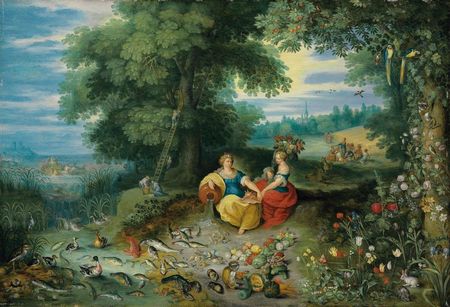Jan Breughel II (Antwerp 1601-1678) and Frans Francken II (Antwerp 1581-1642), An Allegory of Water and Earth
Jan Breughel II (Antwerp 1601-1678) and Frans Francken II (Antwerp 1581-1642), An Allegory of Water and Earth. Photo: Christie's Images Ltd., 2012
oil on panel, 23 5/8 x 34¾ in. (60 x 88.2 cm.). Estimate £250,000 - £350,000 ($389,500 - $545,300)
Provenance: with Galerie Stern, Düsseldorf, 1936, as Jan Breughel I and Hendrick van Balen; sold under duress due to persecution by the National Socialists, September 1936-September 1938.
with Mensing & Zn., Amsterdam, circa 1943-1944.
with J. Dik Jr., Huizen, 1944, when acquired by
Kunsthalle, Hamburg, 1944.
Recovered by the Western Allies.
Transferred to Stichting Nederlands Kunstbezit, The Hague, as Jan Breughel I, 1946 (inventory no. NK2303); Instituut Collectie Nederland, Amsterdam (formerly the Dienst voor 's Rijks Verspreide Kunstvoorwerpen), 1949.
Restituted to the Estate of Max Stern, November 2010.
Literature: Rijksdienst Beeldende Kunst, Catalogue of Old Master Paintings: An illustrated summary catalogue, The Hague, 1992, p. 57, no. 337, illustrated, as Jan Breughel I.
Exhibited: 's-Hertogenbosch, Noordbrabants Museum, on long-term loan, 1949-2010, as Jan Breughel I and Frans Francken II.
Venlo, Limburgs Museum, Asperges in olieverf: een koninklijke groente in de zeventiende eeuw, 22 April 2005-17 July 2005, no. 4C.
Notes: In Allegory of Water and Earth, Jan Breughel II and Frans Francken II join forces to create a colourful and highly detailed image of earth's abundance. Two female figures, the allegorical embodiments of Water and Earth, sit at centre in bright red, yellow and blue garments. Surrounding them is a diverse array of flora and fauna that comprises both indigenous and exotic species. Aquatic creatures, among them various fish, a lobster, ducks and shells, occupy the left-hand side of the composition, opposite terrestrial inhabitants such as guinea pigs, flowers, vegetables and parrots. Related vignettes occupy the distance, including the chariot of Neptune and Amphitrite, pastoral figures climbing a tree and a group of revelers eating, drinking and walking in a field. Through this combination of motifs, Breughel and Francken seamlessly integrated allegorical and mythological imagery with meticulous representation of the natural world.
The present work depicts two elements, and may have been paired with a scene of Air and Fire (K. Ertz, Jan Breughel der Jüngere, Freren, I, 1984, pp. 369-70, nos. 205-6). According to classical tradition, the notion that the world is composed of four elements originated with the fifth-century B.C. philosopher Empedocles, and was later developed by Plato and Aristotle. In sixteenth-century Europe, this concept fit the popular preoccupation with accumulating encyclopedic knowledge of the universe. Manifested in the cabinets of curiosities amassed by figures such as Holy Roman Emperor Rudolf II in Prague, whom Breughel's father Jan the Elder visited in 1604, this quest encompassed both the close study of nature -- a precursor to modern scientific observation -- and a desire for overarching comprehension of the cosmos. This fascination fuelled the popularity of allegorical representations of the Four Elements, particularly in groups of prints.
Breughel and Francken came from two major artistic families in Antwerp, both of which were celebrated for implementing new and innovative systems of artistic production. In their inventive milieu, collaboration was a common working method. This picture is composed of a landscape contributed by Breughel and figures by Francken, in a composition which was painted on several occasions, including a single panel now in the J. Paul Getty Museum, Los Angeles (inventory no. 71.PB.28), and in a series owned by a member of the Belgian Royal Family and sold at Christie's, New York, on 27 January 2010, lot 10. Creating this painting together, they echoed works produced
by Jan the Elder in conjunction with other major artists and peers, including his close friend Sir Peter Paul Rubens. Such projects include a series of the elements begun in 1608 with Hendrick van Balen for the prominent patron Cardinal Federico Borromeo in Milan, now divided between the Ambrosiana, Milan and the Louvre, Paris (K. Ertz, Jan Brueghel der Ältere, Lingen, 2008-10, II, pp. 451-2, no. 195, and III, pp. 1048-68, nos. 499, 505 and 509) and a Five Senses of 1617-1618 painted with Rubens now in the Prado, Madrid (inventory nos. 1394-1398; see A. Woollett and A. van Suchtelen, Rubens and Brueghel: A Working Friendship, Los Angeles and The Hague, 2006, pp. 90-9), among others.
Christie's. Old Master & British Paintings Evening Sale, 3 July 2012. London, King Street

/https%3A%2F%2Fprofilepics.canalblog.com%2Fprofilepics%2F1%2F0%2F100183.jpg)
/https%3A%2F%2Fstorage.canalblog.com%2F03%2F02%2F119589%2F96711876_o.jpg)
/https%3A%2F%2Fstorage.canalblog.com%2F11%2F31%2F119589%2F94773502_o.jpg)
/https%3A%2F%2Fstorage.canalblog.com%2F20%2F83%2F119589%2F94772815_o.jpg)
/https%3A%2F%2Fstorage.canalblog.com%2F26%2F72%2F119589%2F75604929_o.jpg)
/https%3A%2F%2Fstorage.canalblog.com%2F59%2F60%2F119589%2F26458628_o.jpg)



/http%3A%2F%2Fstorage.canalblog.com%2F16%2F03%2F119589%2F96755767_o.jpg)
/http%3A%2F%2Fstorage.canalblog.com%2F00%2F55%2F577050%2F38747647_p.jpg)
/http%3A%2F%2Fstorage.canalblog.com%2F49%2F24%2F119589%2F30154276_o.jpg)
/http%3A%2F%2Fstorage.canalblog.com%2F75%2F50%2F119589%2F110116434_o.jpg)